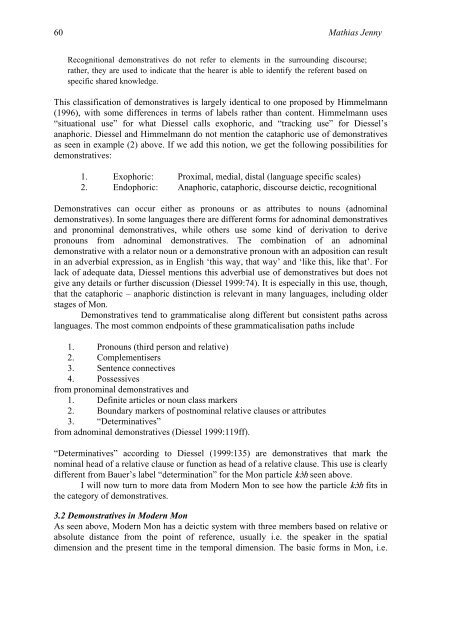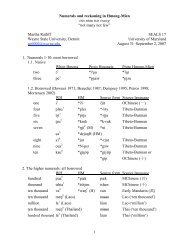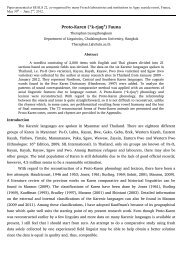proto-southwestern-tai revised: a new reconstruction - seals 22
proto-southwestern-tai revised: a new reconstruction - seals 22
proto-southwestern-tai revised: a new reconstruction - seals 22
Create successful ePaper yourself
Turn your PDF publications into a flip-book with our unique Google optimized e-Paper software.
60 Mathias Jenny<br />
Recognitional demonstratives do not refer to elements in the surrounding discourse;<br />
rather, they are used to indicate that the hearer is able to identify the referent based on<br />
specific shared knowledge.<br />
This classification of demonstratives is largely identical to one proposed by Himmelmann<br />
(1996), with some differences in terms of labels rather than content. Himmelmann uses<br />
“situational use” for what Diessel calls exophoric, and “tracking use” for Diessel’s<br />
anaphoric. Diessel and Himmelmann do not mention the cataphoric use of demonstratives<br />
as seen in example (2) above. If we add this notion, we get the following possibilities for<br />
demonstratives:<br />
1. Exophoric: Proximal, medial, distal (language specific scales)<br />
2. Endophoric: Anaphoric, cataphoric, discourse deictic, recognitional<br />
Demonstratives can occur either as pronouns or as attributes to nouns (adnominal<br />
demonstratives). In some languages there are different forms for adnominal demonstratives<br />
and pronominal demonstratives, while others use some kind of derivation to derive<br />
pronouns from adnominal demonstratives. The combination of an adnominal<br />
demonstrative with a relator noun or a demonstrative pronoun with an adposition can result<br />
in an adverbial expression, as in English ‘this way, that way’ and ‘like this, like that’. For<br />
lack of adequate data, Diessel mentions this adverbial use of demonstratives but does not<br />
give any de<strong>tai</strong>ls or further discussion (Diessel 1999:74). It is especially in this use, though,<br />
that the cataphoric – anaphoric distinction is relevant in many languages, including older<br />
stages of Mon.<br />
Demonstratives tend to grammaticalise along different but consistent paths across<br />
languages. The most common endpoints of these grammaticalisation paths include<br />
1. Pronouns (third person and relative)<br />
2. Complementisers<br />
3. Sentence connectives<br />
4. Possessives<br />
from pronominal demonstratives and<br />
1. Definite articles or noun class markers<br />
2. Boundary markers of postnominal relative clauses or attributes<br />
3. “Determinatives”<br />
from adnominal demonstratives (Diessel 1999:119ff).<br />
“Determinatives” according to Diessel (1999:135) are demonstratives that mark the<br />
nominal head of a relative clause or function as head of a relative clause. This use is clearly<br />
different from Bauer’s label “determination” for the Mon particle kɔ̀h seen above.<br />
I will now turn to more data from Modern Mon to see how the particle kɔ̀h fits in<br />
the category of demonstratives.<br />
3.2 Demonstratives in Modern Mon<br />
As seen above, Modern Mon has a deictic system with three members based on relative or<br />
absolute distance from the point of reference, usually i.e. the speaker in the spatial<br />
dimension and the present time in the temporal dimension. The basic forms in Mon, i.e.





